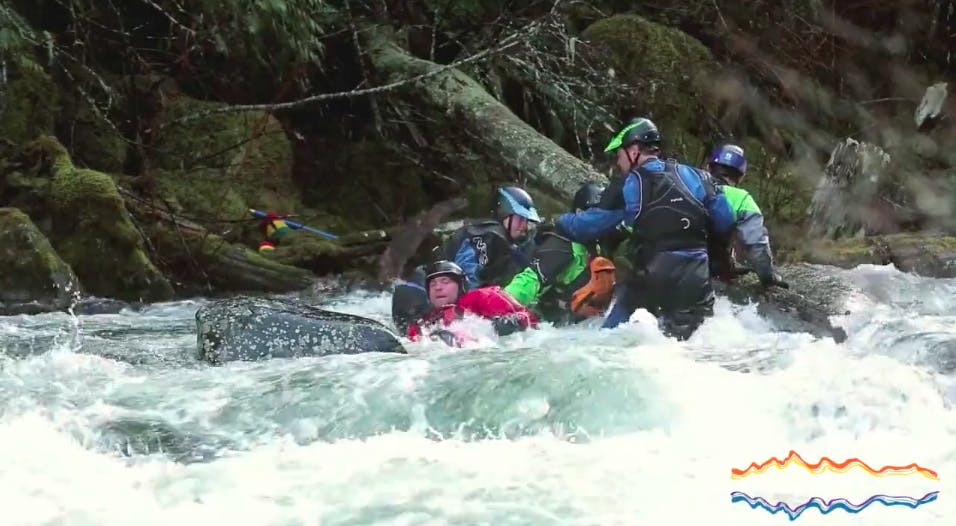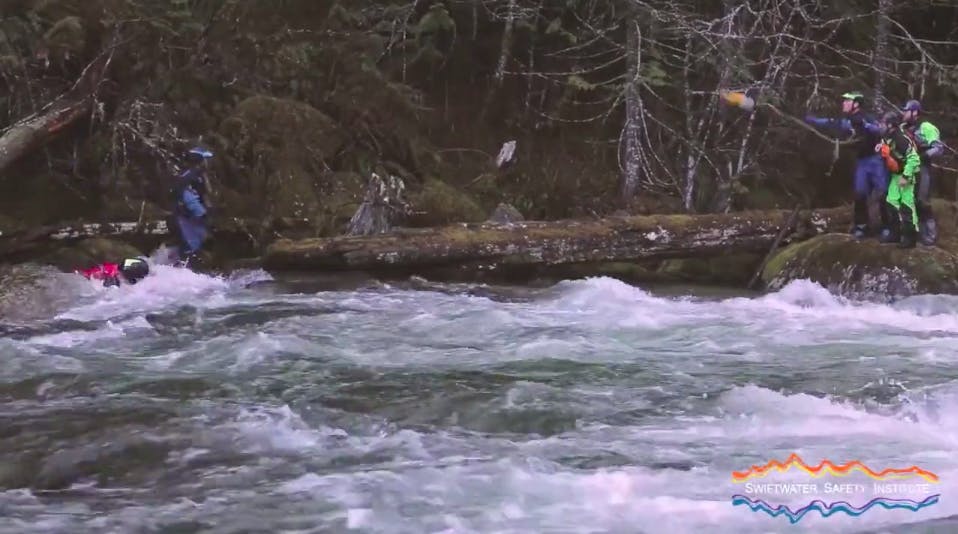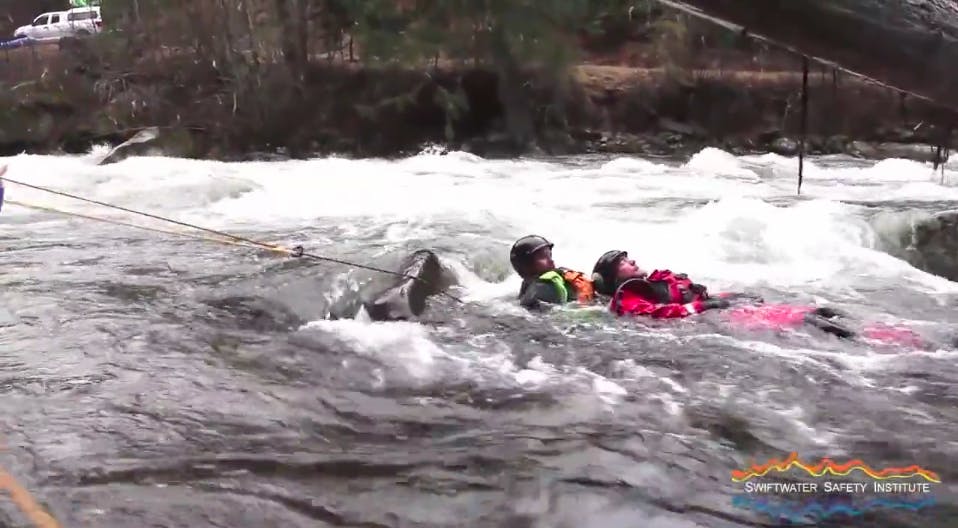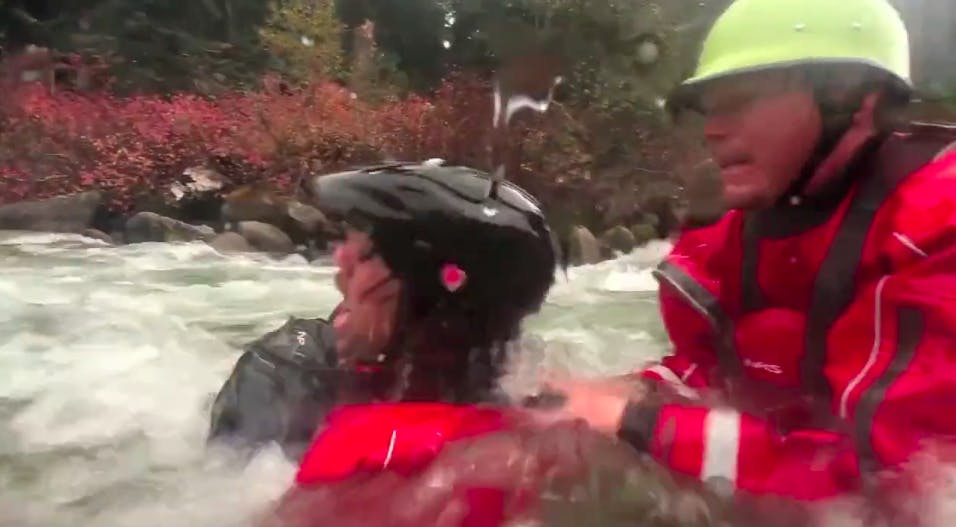Swiftwater safety instructor, Scott Solle, shares information on how to assist a fellow packrafter with a foot entrapment
Disclaimer: This post is in not intended to be a substitute for proper training. No book or blog post can replace proper instruction nor practice of the techniques taught in a formal river rescue or swiftwater rescue class. Therefore, this post should not be used as a substitute for such training.

By Scott Solle, an instructor with the Swiftwater Safety Institute, and owner of Moab based Solgear. Photos and illustration courtesy of the Swiftwater Safety Institute.
The first time that I hopped into a small packraft was 2007 when Roman Dial, someone I had never met, invited me to Anchorage to teach a swiftwater rescue class as part of a college packrafting course. I had been teaching swiftwater, mostly throughout Alaska, since 1999 and this seemed like a perfect opportunity to extend my experience. We agreed to meet up at Alaska Pacific University to teach river rescue skills to packrafters, or soon-to-be packrafters. I planned to provide traditional river rescue skills while at the same time discover new skills specific to packrafting.
Following our first day was a typical dry land instruction, we headed to Eagle River for day two, where after swimming and demonstrating throw-bagging, we decided to inflate the packrafts and see what skills might be appropriate for the level of our students. The most obvious skill was to be able to climb back into the boat upon overturning. This skill is known as the “wet entry.” The very first attempts at a wet entry showed the instincts of the inexperienced river traveler. Like many rivers in Alaska, Eagle River is shallow in many spots. Several students attempted to wet entry by standing up in the river and jumping into their boats. Standing up in swift moving water is dangerous. I don’t like to use terms like ever, never, or always, but I would say that you should never stand up in moving water. While we covered many skills during our time on Eagle River, I would like to focus this article on the rescue of someone who overturned their packraft and fell victim to a foot entrapment as the result of standing up in moving water while attempting a wet entry.
SSI-AR Foot Entrapment Audio from Swiftwater Safety Institute on Vimeo.
What is “Swift” Water?
Not all moving water is “swift” water, and there have been many times I have stood in moving water that is not defined as swift. I like to define swiftwater as any moving water in which I am unable to control my own movements. This could be water from merely a few inches deep to several feet deep. Swiftwater is often determined by the velocity of the river and the composition of the river’s substrate. A slippery river bottom may not need much velocity or depth to knock someone off their feet, while a slow-moving river in which one can find good traction may allow you to control your movements in deeper water. As soon as you are no longer in control of your own movements, I consider this to be swiftwater. If you stand up in swiftwater, you immediately run the risk of snagging a foot in between rocks or branches, or any number of things that may or may not be visible. Once one’s foot is snagged or “entrapped” the force of the river’s current will push them over and the victim is now face down in the river. Once a victim is face down in moving water they are not in control, and it is only a matter of time before they succumb to hypothermia, exhaustion, or both, and then drown.
When Foot Entrapment Occurs, What To Do?
Consider you’re on packrafting trip with some friends, and the river is of a depth and velocity that one could walk into and have control of their movements. But one of your friends with very little river experience overturns and instinctively stands up in the river to wet entry, but within seconds becomes foot entrapped. It is now your responsibility to try to positively affect your friend’s predicament. It’s unlikely one would be able to do much as they float by this victim, with his or her body hunched over, head downstream. Hopefully the first person who saw this happen alerts the rest of the party with a whistle blast, or three. The party must then paddle to the river’s edge, get out of their boats and run back upstream to start a rescue. Being able to make physical contact with the victim is the victim’s best chance of survival. But just making contact is not enough. The rescuer must decide if it is better to be upstream or downstream of the victim. Being upstream may provide the victim with a small eddy, and even allow for better positioning to extricate the victims foot from the entrapment. However, the rescuer may be exposed to the same danger that ensnared the victim. A downstream approach may provide more safety to the rescuer and provide better positioning to get the victim’s head up and out of the water, but it may be more difficult to extricate the entrapment. The river’s topography might dictate this decision and the rescuer will be left to do his/her best given the circumstances.
Walking or Wading

If walking or wading to the victim is difficult due to the velocity of the current, it may be possible to utilize more than one person in a group wading technique known as “shallow water crossing.” This basic technique jis taught in most swiftwater rescue classes. The key to this procedure is the fact that two or more rescuers working together have better stability and control of movement in faster current. A group of people working their way to the victim may provide needed stability to a rescuer in an attempt to extricate the entrapment and free the victim.
Type V Rescue PFD
Another way to wade to the victim and have added control is to utilize a Type V rescue PFD. A Type V rescue PFD has a tethering point that is releasable by the rescuer. A tethered rescuer can wade to the victim from an upstream location. This type of rescue requires a practiced belayer (the person upstream feeding rope) and a practiced rescuer (the person giving commands to the belayer and wading to the victim). Tethering yourself in a river is risky, and rescuers using a Type V rescue PFD should receive training in a formal swiftwater rescue class prior to the use of this type of vest.
Rope Techniques

What if walking or wading to the victim is not possible? If a person were to become entrapped in an area of the river where it is not possible for a group to access the victim by wading, then it is much more likely that the victim will succumb to the relentless power of the river. There are many techniques you can read about in river rescue books utilizing ropes as a way to access and stabilize the victim or even extricate and transport the victim to the river’s edge. Many of these rope techniques require extensive teamwork, good communication, good planning, good positioning, and accurate rope throwing, all of which take a good deal of practice. The basic idea of most of the rope techniques is to first try to stabilize the situation and then work towards pulling the victim out of the entrapment. The bottom line for packrafters is that none of the following techniques will be possible if no one has a rope and most will not be possible with only one rope. Therefore, it is my recommendation that every packrafter carry a throw rope as part of their paddling gear.

Rope Technique Example 1: Double Shore Technique
The first rope technique is the “double shore technique.” This technique only works if the river is narrow enough to throw a rope across the entire river. Imagine again that your friend has become foot entrapped and your group was aware enough to split up into teams on river right and river left. A rope is then tossed across the river between the teams positioned downstream of the victim and dragged upstream and under the arms of the victim. This is known as the stabilization line. This line will need to move upstream so that the angle created with the victim at the apex is less than 90 degrees. Ideally, this line keeps the victim’s head above the surface of the water and thus able to maintain their airway. The stabilization line might be all the victim needs to free the entrapment. If not, another line will need to cross the river downstream of the victim, and then be pulled upstream with the goal of snagging low on the victim’s body. However, float ropes found in most throw bags can make it difficult to achieve the goal of getting a rope low on the victim’s body. The best method to assist in this process is to connect two throwbags together so that both bags are in the middle of one longer rope. One of these bags can be weighted with river cobble, allowing the rope to submerge to better accomplish the goal of snagging low on the victim’s body. Once the victim has been “snagged,” efforts are then made to pull the victim free. The general theory is that the entrapment must come out the way it went in.
Rope Technique Example 2: Rope Cinches
If the victim has been snagged and attempts to pull the victim upstream are unsuccessful, options are few. There are several different cinch methods in books, all of which get more complicated and involve more rope and rescuers. The more rescuers, rope and technique involved, the more important it is to be well-trained and practiced. The general idea behind cinching the victim is to maintain a secure connection while efforts are made to pull the victim out. Often, many different directions of pull must be employed in order to free the victim. However, a rope cinch around the torso of a body can cause its own trauma. Because of this, many variations of the cinch lend to different levels of control and the amount of pressure applied on the victim. Among the variety of cinches available are: Bechdel Cinch, Carlson Cinch, and Mather’s Cinch. And while each can be effective, it takes a well-trained and practiced team to carry them out. Due to the complexity, the amount of personnel and gear required, we will save the intricacies of cinch descriptions for future posts.
Rope Technique Example 3: Single Shore Rescue with the “Double Coil” or “Two Step Toss”
While operating a rescue from both river right and river left is a good option, it is not always possible. The river may be too wide, or access may be blocked by the makeup of the riverbank. Therefore, the possibility exists that you are trying to affect a rescue of an entrapped victim from a single shore. However, the basics to this rescue are similar to a double shore rescue in that we must stabilize the victim and then extricate the entrapment using rope technique. The end goal will be to get a rope around the victim to act as a stabilizing line and a snag/extrication line.
There are a few techniques that can accomplish this, and all are difficult. First is a technique known as the “double coil” or “two step toss”. The limit to this method is dependant on how far one can toss a coil or rope, or better yet how far two people can toss two coils of rope at the same time. Two rescuers each hold an end of one rope in one hand and coil towards the middle of the rope in the other. Then they work together to toss the coils of rope over the victim’s head. A second option is to throw swim a rope to the far side of the victim. It is unlikely that one would be able to swim the rope back to the near shore and instead should have an additional rescuer ready to retrieve the swimmer via throw rope. The goal is to get a bight of rope around the victim. A third option requires throwing a rope from shore so that it snags the victim with the rope end and bag trailing downstream of the victim. The rescuers will then need to try and snag this trailing end of the rope and pull it to shore. There are commercially made devices one can install on a throw bag to assist in a rope snag such as a “Snag Plate,” and one can easily make a homemade version of this. Again, we see this requires more rope and gear. Once rescuers get a loop of rope around the victim, they need to cross these lines to form a simple cinch and move upstream in an effort to pull the victim free. Rescuers should continue pull the victim in several different directions until the victim is free of entrapment.
Strong Swimmer

Unfortunately, there is the possibility that rescuers can get a rope around a victim and go through all the techniques described and still be unable to free an entrapped victim. If rope techniques were used because wading was not an option, you may now have a line to the victim to allow for one more option, the “strong swimmer.” The line to the victim can possibly be used in a hand over hand movement using the rope for support, or by clipping a carabineer and using the current to travel from upstream to downstream in a type of zip line, providing another method to access the victim. Upon reaching the victim, the same problem of extricating the entrapment must be solved.
Conclusion
To this point, we have not discussed anything about what to do once the victim has been extricated, such as getting to shore or any medical treatment they might require, including possible resuscitation or splinting for a fractured leg. First aid and rescue in the wilderness is something every packrafter should be ready for and it is just as important to possess these skills, as it is to have a good packraft or paddle. I have practiced these extrication techniques many times with people of various skills and I understand the risk and difficulty of each technique. Despite knowing how to react, I prefer to be proactive and simply keep my feet near the surface of the river. I’d rather have a story of how much fun I had paddling than a story of how I almost drown by acting complacent and putting my feet down when I wasn’t in control.